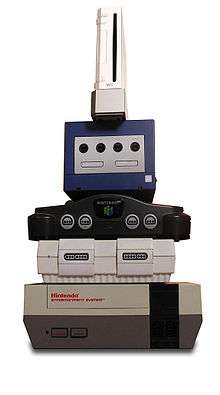Game Boy family
The Game Boy family is a line of handheld game consoles developed, manufactured, released and marketed by Nintendo, consisting of the Game Boy and its revisions, the Game Boy Color and the Game Boy Advance family.[3][4] The product line has sold over 200 million units worldwide.[5][6]
Top: Logo of the original Game Boy (For the logos of the other models, see their articles) Bottom: All models of the Game Boy family chronologically from left to right: Game Boy, Game Boy ("Play It Loud!" model), Game Boy Pocket, Game Boy Light, Game Boy Color, Game Boy Advance, Game Boy Advance SP, Game Boy Advance SP (backlight model), Game Boy Micro | |
| Developer | Nintendo |
|---|---|
| Type | Family of handheld game consoles |
| Generation | Game Boy, Game Boy Pocket, Game Boy Light: Fourth generation Game Boy Color: Fifth generation Game Boy Advance, Game Boy Advance SP, Game Boy Micro: Sixth generation |
| Lifespan | 1989[1]–2010[2] |
| Units sold | Game Boy/Game Boy Color: 118.7 million Game Boy Advance: 81.5 million |
| Media | Game Boy Game Pak Game Boy Color Game Pak Game Boy Advance Game Pak |
| Predecessor | Game & Watch series |
| Successor | Nintendo DS family |
The original Game Boy (ゲームボーイ, Gēmu Bōi) and Game Boy Color combined[7] sold 118.69 million units worldwide.[5] All versions of the Game Boy Advance family combined have sold 81.51 million units.[5] All Game Boy systems combined have sold 200.20 million units worldwide.
The Game Boy line was succeeded by the Nintendo DS line. A number of Game Boy, Game Boy Color, and Game Boy Advance games have been rereleased digitally through the Virtual Console service for the Nintendo 3DS and Wii U.
History
| 1989 | Game Boy |
|---|---|
| 1990 | |
| 1991 | |
| 1992 | |
| 1993 | |
| 1994 | |
| 1995 | |
| 1996 | Game Boy Pocket |
| 1997 | |
| 1998 | Game Boy Light |
| Game Boy Color | |
| 1999 | |
| 2000 | |
| 2001 | Game Boy Advance |
| 2002 | |
| 2003 | Game Boy Advance SP |
| 2004 | |
| 2005 | Game Boy Micro |
Nintendo's Game Boy handheld was first released in 1989.[8] The gaming device was the brainchild of long-time Nintendo employee Gunpei Yokoi, who was the person behind the Ultra Hand, an expanding arm toy created and produced by Nintendo in 1970, long before Nintendo would enter the video game market. Yokoi was also responsible for the Game & Watch series of handhelds when Nintendo made the move from toys to video games.
When Yokoi designed the original Game Boy, he knew that to be successful, the system needed to be small, light, inexpensive, and durable, as well as have a varied, recognizable library of games upon its release. By following this simple mantra, the Game Boy line managed to gain a vast following despite technically superior alternatives which would have color graphics instead. This is also apparent in the name (conceived by Shigesato Itoi), which connotes a smaller "sidekick" companion to Nintendo's consoles.
Game Boy continues its success to this day and many at Nintendo have dedicated the handheld in Yokoi's memory. Game Boy celebrated its 15th anniversary in 2004, which nearly coincided with the 20-year anniversary of the original Nintendo Entertainment System (NES). To celebrate, Nintendo released the Classic NES Series and an NES controller-themed color scheme for the Game Boy Advance SP.
In 2006, Nintendo president Satoru Iwata said on the rumored[9] demise of the Game Boy brand: "No, it's not true after all. What we are repeatedly saying is that for whichever platform, we are always conducting research and development for the new system, be it the Game Boy, or new console or whatever. And what we just told the reporter was that in thinking about the current situation where we are enjoying great sales with the DS and that we are now trying to launch the Wii, it's unthinkable for us to launch any new platform for the handheld system, including the new version of the GBA... Perhaps they misunderstood a part of this story, but as far as the handheld market is concerned [right now] we really want to focus on more sales of the DS; that's all" until Nintendo ceased the production of the Game Boy Advance games and handheld system in North America on May 15, 2010.[10]
Classic Game Boy family
Game Boy
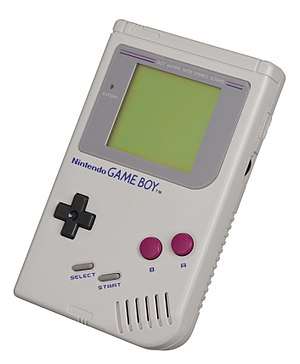
The original gray Game Boy was first released in Japan on April 21, 1989. Based on a Z80 processor, it has a black and green reflective LCD screen, an eight-way directional pad, two action buttons (A and B), and Start and Select buttons with the controls being identical to the NES controller. It plays games from ROM-based media contained in cartridges (sometimes called carts or Game Paks). Its graphics are 8-bit (similar to the NES).
The game that pushed the Game Boy into the upper reaches of success was Tetris. Tetris was widely popular, and on the handheld format could be played anywhere. It came packaged with the Game Boy, and broadened its reach; adults and children alike were buying Game Boys in order to play Tetris. Releasing Tetris on the Game Boy was selected as #4 on GameSpy's "25 Smartest Moments in Gaming".[11]
The original Game Boy was one of the first cartridge-based systems that supported more than four players at one time (via the link port). In fact, it has been shown that the system could support 16 simultaneous players. However, this feature was only supported in Faceball 2000.
In 1995, the "Play it Loud" version of the original Game Boy was released in six different colors; black, red, yellow, green, blue, white and clear. With sports variations in between.
Game Boy Pocket
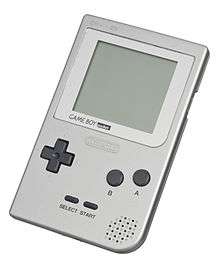
The Game Boy Pocket is a redesigned version of the original Game Boy having the same features. It was released in 1996. Notably, this variation is smaller and lighter. It comes in seven different colors; red, yellow, green, black, clear, silver, blue, and pink.
Another notable improvement over the original Game Boy is a black-and-white display screen, rather than the green-tinted display of the original Game Boy, that also featured improved response time for less blurring during motion. The Game Boy Pocket takes two AAA batteries as opposed to four AA batteries for roughly ten hours of gameplay. The first model of the Game Boy Pocket did not have an LED to show battery levels, but the feature was added due to public demand.
Game Boy Light
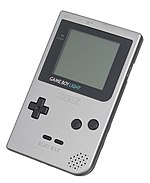
In April 1998, a variant of the Game Boy Pocket named Game Boy Light was exclusively released in Japan. The differences between the original Game Boy Pocket and the Game Boy Light is that the Game Boy Light takes on two AA batteries for approximately 20 hours of gameplay (when playing without using the light), rather than two AAA batteries, and it has an electroluminescent screen that can be turned on or off. This electroluminescent screen gave games a blue-green tint and allowed the use of the unit in darkened areas. Playing with the light on would allow about 12 hours of play. The Game Boy Light also comes in six different colors; silver, gold, yellow for the Pokémon edition, translucent yellow, clear and translucent red for the Astro Boy edition. The Game Boy Light was superseded by the Game Boy Color six months later and was the only Game Boy to have a backlit screen until the release of the Game Boy Advance SP AGS-101 model in 2005.
Game Boy Color family
Game Boy Color
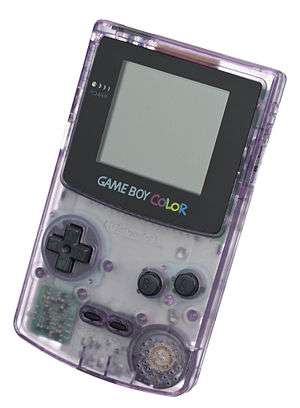
First released in Japan on October 21, 1998, the Game Boy Color (abbreviated as GBC) added a (slightly smaller) color screen to a form factor similar in size to the Game Boy Pocket. It also has double the processor speed, three times as much memory,[12] and an infrared communications port. Technologically, it was likened to the 8-bit NES video game console from the 1980s although the Game Boy Color has a much larger color palette (56 simultaneous colors out of 32,768 possible) which had some classic NES ports and newer titles. It comes in seven different colors; Clear purple, purple, red, blue, green, yellow and silver for the Pokémon edition. Like the Game Boy Light, the Game Boy Color takes on two AA batteries. It was the final handheld to have 8-bit graphics.
A major component of the Game Boy Color is its near-universal backward compatibility; that is, a Game Boy Color is able to read older Game Boy cartridges and even play them in a selectable color palette (similar to the Super Game Boy). The only black and white Game Boy games known to be incompatible are Road Rash and Joshua & the Battle of Jericho. Backwards compatibility became a major feature of the Game Boy line, since it allowed each new launch to begin with a significantly larger library than any of its competitors. Some games written specifically for the Game Boy Color can be played on older model Game Boys, whereas others cannot (see the Game Paks section for more information).
Game Boy Advance family
Game Boy Advance
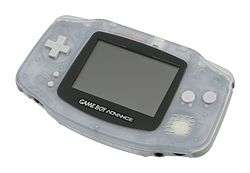
In Japan, on March 21, 2001, Nintendo released a significant upgrade to the Game Boy line. The Game Boy Advance (also referred to as GBA) featured a 32 bit 16.8 MHz ARM. It included a Z80 processor and a switch activated by inserting a Game Boy or Game Boy Color game into the slot for backward compatibility, and had a larger, higher resolution screen. Controls were slightly modified with the addition of "L" and "R" shoulder buttons. Like the Game Boy Light and Game Boy Color, the Game Boy Advance takes on two AA batteries. The system was technically likened to the SNES and showed its power with successful ports of SNES titles such as Super Mario World, Super Mario World 2: Yoshi's Island, The Legend of Zelda: A Link to the Past and Donkey Kong Country. There were also new titles that could be found only on the GBA, such as Mario Kart: Super Circuit, F-Zero: Maximum Velocity, Wario Land 4, Mario & Luigi: Superstar Saga and more. A widely criticized drawback of the Game Boy Advance is that the screen is not backlit, making viewing difficult in some conditions. The Game Paks for the GBA are roughly half the length of original Game Boy cartridges and Game Boy Color cartridges, and so older Game Paks would stick out of the top of the unit. When playing older games, the GBA provides the option to play the game at the standard equal square resolution of the original screen or the option to stretch it over the wider GBA screen. The selectable color palettes for the original Game Boy games are identical to what it was on the Game Boy Color. The only Game Boy Color games known to be incompatible are Pocket Music[13] and Chee-Chai Alien.[14][15] It was the final handheld to require regular batteries.
Game Boy Advance SP
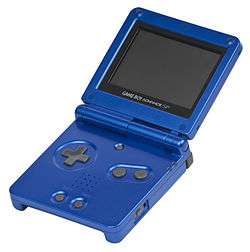
First released in Japan on February 14, 2003, the Game Boy Advance SP—Nintendo model AGS-001—resolved several problems with the original Game Boy Advance model. It featured a new smaller clamshell design with a flip-up screen, a switchable internal frontlight, a rechargeable battery for the first time, and the only notable issue is the omission of the headphone jack, which requires a special adapter, purchased separately. In September 2005, Nintendo released the Game Boy Advance SP model AGS-101, that featured a high quality backlit screen instead of a frontlit, similar to the Game Boy Micro screen but larger. It was the final Game Boy and last handheld to have backwards compatibility with Game Boy and Game Boy Color games.
Game Boy Micro
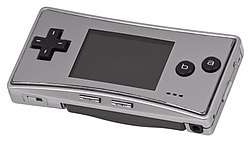
The third form of Game Boy Advance system, the Game Boy Micro is four and a half inches wide (10 cm), two inches tall (5 cm), and weighs 2.8 ounces (80 g). By far the smallest Game Boy created, it has approximately the same dimensions as an original NES controller pad. Its screen is approximately 2/3 the size of the SP and GBA screens while maintaining the same resolution (240×160 pixels) but now has a higher quality backlit display with adjustable brightness. Included with the system are two additional faceplates which can be swapped to give the system a new look; Nintendo of America sold additional faceplates on its online store. In Europe, the Game Boy Micro comes with a single faceplate. In Japan, a special Mother 3 limited edition Game Boy Micro was released with the game in the Mother 3 Deluxe Box. Unlike the Game Boy Advance and Game Boy Advance SP, the Game Boy Micro is unable to play any original Game Boy or Game Boy Color games, only playing Game Boy Advance titles (with the exception of the Nintendo e-Reader, discontinued in America, but still available in Japan).
Comparison
| Product family | Game Boy Advance | Game Boy Color | Classic Game Boy | ||||
|---|---|---|---|---|---|---|---|
| Name | Game Boy Micro | Game Boy Advance SP | Game Boy Advance | Game Boy Color | Game Boy Light | Game Boy Pocket | Game Boy |
| Model # | OXY-001 | AGS-001 / AGS-101 | AGB-001 | CGB-001 | MGB-101 | MGB-001 | DMG-01 |
| Logo | |||||||
| Image | 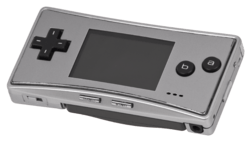 |
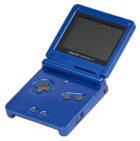  |
 |
 |
 |
 |
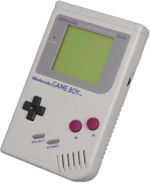 |
| In production | Discontinued | ||||||
| Generation | Sixth generation | Fifth generation | Fourth generation | ||||
| Release date | |||||||
| Launch price | ¥12,000[16] |
¥12,500[17] US$99[17] |
¥9,800 US$99.99[24] |
¥8,900 US$79.95 |
¥6,800 | ¥6,800 US$59.95 |
¥12,800 US$89.95 |
| Units shipped | Worldwide: 81.51 million (as of December 31, 2013).[5] | Worldwide: 118.69 million (as of December 31, 2013)[5][7] | |||||
| Best-selling game |
Pokémon Ruby and Sapphire, 13 million combined (as of November 25, 2004)[25] |
Pokémon Gold and Silver, |
Tetris, 30.26 million (pack-in/separately) | ||||
| Display | 51 mm (2 in) | 74 mm (2.9 in) | 59 mm (2.34 in) | 65 mm (2.56 in) | |||
| 240 × 160 px (38,400 px)[28][29] | 160 × 144 px (23,040 px)[30][31][32] | ||||||
| 511 simultaneous colors in character mode 32,768 simultaneous colors in bitmap mode[28] |
10, 32 or 56 simultaneous colors (from a 32,768 color palette)[32] |
4 shades, monochromatic (2-bit)[30][31] | |||||
| White screen (four shades, greyscale) |
Olive green screen (four shades of olive green) | ||||||
| Backlight – 5 brightness levels | Frontlight On/Off toggle (AGS-001) Backlight Bright/Normal toggle (AGS-101) |
No backlight | No backlight | Electro-Luminescent Backlight On/Off toggle | No backlight | No backlight | |
| Audio | 6 channels (two 8-bit "Direct Sound" PCM channels, plus the 4 channels from Game Boy) |
4 channels (2 square wave channels, 1 PCM 4-bit wave sample channel, 1 noise channel and 1 audio input from the cartridge)[30][32] | |||||
| Single mono speaker[30][33] | |||||||
| Stereo headphone jack (standard)[33] |
Stereo headphone jack (for headphones specifically designed for the GBA SP or by using the headphone adapter) |
Stereo headphone jack (standard)[32] | |||||
| Processor | 16.8 MHz 32-bit ARM7TDMI 4 or 8 MHz 8-bit Z80 coprocessor for Game Boy and Game Boy Color emulation, and as a tone generator in Game Boy Advance games |
4 or 8 MHz 8-bit Zilog Z80 | 4.19 MHz 8-bit custom Sharp LR35902 | ||||
| Memory | 256 kB WRAM (outside the CPU) 32 kB + 96 kB VRAM (internal to the CPU) |
32 kB RAM 16 kB VRAM |
8 kB S-RAM[34] (can be extended up to 32 kB)[31] 8 kB VRAM[30] | ||||
| Physical media | Game Boy Advance Game Cartridge (2-32 MB) | Game Boy Advance Game Cartridge (2-32 MB) Game Boy Color Game Cartridge |
Game Boy Color Game Cartridge Game Boy Game Cartridge |
Game Boy Game Cartridge (32 kB – 1 MB)[30] | |||
| Input controls |
|
| |||||
| Batteries | 460 mAh lithium-ion battery
|
700 mAh lithium-ion battery[35] | 2 AA batteries
(dependent on the Game Pak being played and volume setting)[36] |
2 AA batteries | 2 AA batteries
|
2 AAA batteries | 4 AA batteries |
| DC input | Proprietary (micro type)
5 V DC |
Proprietary (SP type)
5 V DC |
None | Barrel 2.35 mm x 0.75 mm (Center Positive)
3 V DC |
Barrel 3.5 mm x 1.5 mm (Center Negative)
6 V DC | ||
| Connectivity | Fourth generation link port | Third generation link port | Second generation link port | First generation link port | |||
| N/A | Infrared port | N/A | |||||
| Weight | 80 grams (2.8 oz) | 142 grams (5.0 oz) | 140 grams (4.9 oz) | 138 grams (4.9 oz)[37][38] | 190 grams (6.7 oz) (with batteries)[19] | 125 grams (4.4 oz)[37]150 grams (5.3 oz) (with batteries)[20] | 220 grams (7.8 oz)[37]
394 grams (13.9 oz) (with batteries)[39] |
| Dimensions |
101 mm (4.0 in) W |
84 mm (3.3 in) W |
144 mm (5.7 in) W |
75 mm (3.0 in) W |
80 mm (3.1 in) W |
77.6 mm (3.06 in) W |
90 mm (3.5 in) W |
| Colors and styles | List of Game Boy colors and styles | ||||||
| Regional lockout | No | ||||||
| List of games | List of Game Boy Advance games | List of Game Boy Color games | List of games for the original Game Boy | ||||
| Backward compatibility | N/A[40] | Game Boy Game Boy Color[28] |
Game Boy | N/A | |||
| Name | Game Boy Micro | Game Boy Advance SP | Game Boy Advance | Game Boy Color | Game Boy Light | Game Boy Pocket | Game Boy |
- Game Boy line size comparison
 Comparing the sizes of some Game Boy systems, from top-left: Game Boy (1989), Game Boy Pocket (1996), Game Boy Color (1998), Game Boy Advance (2001), Game Boy Advance SP (2003), Game Boy Micro (2005)
Comparing the sizes of some Game Boy systems, from top-left: Game Boy (1989), Game Boy Pocket (1996), Game Boy Color (1998), Game Boy Advance (2001), Game Boy Advance SP (2003), Game Boy Micro (2005)
Game Paks
Each video game is stored on a plastic cartridge, officially called a "Game Pak" by Nintendo. All cartridges, excluding those for Game Boy Advance, measure 5.8 by 6.5 cm. The cartridge provides the code and game data to the console's CPU. Some cartridges include a small battery with SRAM, flash memory chip, or EEPROM, which allows game data to be saved when the console is turned off. If the battery runs out in a cartridge, then the save data will be lost, however, it is possible to replace the battery with a new battery. To do this, the cartridge must be unscrewed, opened up, and the old battery would be removed and replaced. This may require desoldering the dead battery and soldering the replacement in place. Before 2003, Nintendo used round, flat watch batteries for saving information on the cartridges. These batteries were replaced in newer cartridges because they could only live for a certain amount of time.
The cartridge is inserted into the console cartridge slot. If the cartridge is removed while the power is on, and the Game Boy does not automatically reset, the game freezes; the Game Boy may exhibit unexpected behavior, such as rows of zeros appearing on the screen, the sound remaining at the same pitch as was emitted the instant the game was pulled out, saved data may be corrupted, and hardware may be damaged. This applies to most video game consoles that use cartridges.
The original Game Boy power switch was designed to prevent the player from being able to remove the cartridge while the power is on. Cartridges intended only for Game Boy Color (and not for the original Game Boy) lack the "notch" for the locking mechanism present in the top of the original cartridges, preventing operation on an original Game Boy (the cartridge can be inserted, but the power switch cannot be moved to the "on" position). Even if this was bypassed by using a Game Boy Pocket, Game Boy Light, or Super Game Boy (and its Japanese-only follow-up), the game would not run, and an image on the screen would inform the user that the game is only compatible with Game Boy Color systems. One exception would be the Kirby Tilt 'n' Tumble game: despite the game cartridge featuring a notch, enabling it to be inserted on the original Game Boy, the game displays an error message indicating that it only plays on Game Boy Color. Chee Chai Alien[41][42] and Pocket Music[43] are incompatible with Game Boy Advance models, displaying an error message indicating that they only play on Game Boy Color.
Game Boy Advance cartridges used a similar physical lock-out feature. Notches were located at the base of the cartridge's two back corners. One of these notches was placed as to avoid pressing a switch inside the cartridge slot to help stabilize it. When an older Game Boy or Game Boy Color game was inserted into the cartridge slot, the switch would be pressed down and the Game Boy Advance would start in Game Boy Color mode, while a Game Boy Advance cartridge would not touch the switch and the system would start in Game Boy Advance mode. The Nintendo DS replaced the switch with a solid piece of plastic that would allow Game Boy Advance cartridges to be inserted into Slot 2, but would prevent an older Game Boy or Game Boy Color cartridge from being inserted fully into the slot.
Excluding game-specific variations, there are four types of cartridges compatible with Game Boy systems:
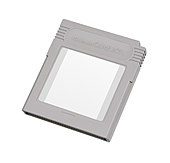
- Grey cartridges (Also known as class A) are compatible with all Game Boy systems, excluding Game Boy Micro. All original Game Boy games are of this type. Some of these cartridges are in alternative colors, such as red or blue for Pokémon Red and Blue, and yellow for the Donkey Kong Land series. The games on these cartridges are programmed in black and white; the Game Boy Color and later systems provide selectable color palettes for them. Some grey cartridges that were released between 1994 and 1998 have Super Game Boy enhancements. Even fewer grey cartridges were released with built-in features that made them protrude from the slot, but included the notch to be compatible with the original Game Boy (notably the Game Boy Camera)
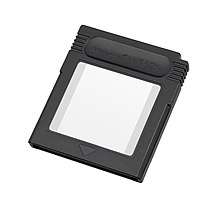
- Black cartridges (Also known as class B or Dual Mode) are compatible with all Game Boy systems, excluding Game Boy Micro. Although the games on these cartridges are programmed in color, they can still be played in monochrome on Game Boy, Game Boy Pocket, Game Boy Light and Super Game Boy (and its Japanese follow-up). Examples of black-cartridge games are Pokémon Yellow: Special Pikachu Edition, Pokémon Gold and Silver (however, the actual colors of these three cartridges are yellow, gold, and silver, respectively). Games such as Wario Land II and The Legend of Zelda: Link's Awakening DX were full-color re-releases of gray-cartridge games but with additional content only available on the Game Boy Color. Some black cartridges have Super Game Boy enhancements. Even some games had built-in features similar to what the later clear cartridges did, like rumble features (Pokémon Pinball)[44] and infrared receiver (Robopon Sun, Star, and Moon Versions).[45]
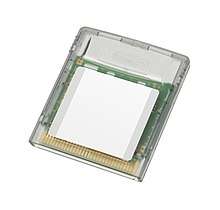
- Clear cartridges (Also known as class C) are compatible with Game Boy Color and the Game Boy Advance systems, excluding Game Boy Micro. Some games (such as Pokémon Crystal) were released in specially colored cartridges, as had been done before, but the new colors remained translucent. Some clear cartridges have built-in features, including rumble features (Perfect Dark) and tilt sensors (Kirby Tilt 'n' Tumble). These cartridges are a slightly different shape from the earlier varieties, and would obstruct the latch if inserted into the original Game Boy. Unlike the Gray cartridges and Black cartridges, the Clear cartridges cannot be played on a Game Boy Pocket, a Game Boy Light or on Super Game Boy (or even its Japanese follow-up). Some class C cartridges (European version of V-Rally: Championship Edition) used a solid cartridge design, like in Class B.[46]

- Advance cartridges (Also known as class D) are half the size of all earlier cartridges and are compatible with Game Boy Advance and later systems including the Nintendo DS. Some cartridges are colored to resemble the game (usually for the Pokémon series; Pokémon Emerald, for example, being a clear emerald green). They are also compatible with Nintendo DS and DS Lite (but see the Reception section for limitations). Some Advance cartridges have built-in features, including rumble features (Drill Dozer), tilt sensors (WarioWare: Twisted!, Yoshi's Universal Gravitation) and solar sensors (Boktai).
Accessories
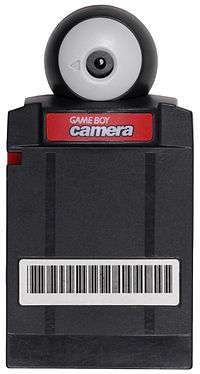
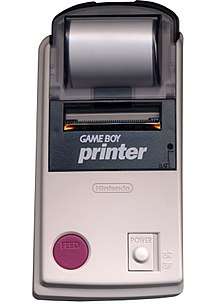
The Game Boy, as with many other consoles, has had a number of releases from both first-party and unlicensed third-party accessories. The most notable being the Game Boy Camera (left) and the Game Boy Printer (right), which were released in 1998.
Television adapters
In addition to the Game Boy, special hardware has been released for various handhelds in the Game Boy line so they can be played on a television set.
Super Game Boy
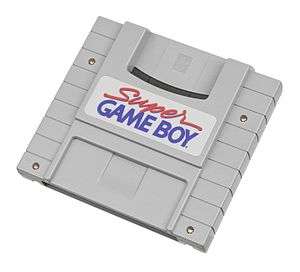
In 1994, a special adapter cartridge for Nintendo's Super Nintendo Entertainment System (SNES) was released called the Super Game Boy. The Super Game Boy allows game cartridges designed for use on the Game Boy to be played on a TV display using the SNES/Super Famicom controllers. When it was released in 1994, the Super Game Boy sold for about $60 in the United States. In the United Kingdom, it retailed for £49.99. The Super Game Boy's technical architecture is similar to that of a regular Game Boy, thus Game Boy games functioned on the native hardware rather than being emulated by the SNES. It was the precursor to the Game Boy Player on the Nintendo GameCube, which functioned in a similar manner.
Super Game Boy 2
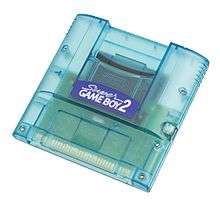
A follow-up of the Super Game Boy, the Super Game Boy 2 was released only in Japan in 1998. The border is similar to that of actual Game Boy Pocket hardware, but it includes an actual link cable port, and the clock speed is slowed down to match that of the Game Boy.
Game Boy Player
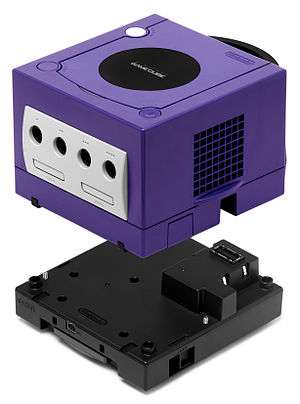
The Game Boy Player is a device released in 2003 by Nintendo for the GameCube which enables Game Boy (although Super Game Boy enhancements are ignored), Game Boy Color, or Game Boy Advance cartridges to be played on a television. It connects via the high speed parallel port at the bottom of the GameCube and requires use of a boot disc to access the hardware. Unlike devices such as Datel's Advance Game Port, the Game Boy Player does not use software emulation, but instead uses physical hardware nearly identical to that of a Game Boy Advance.
Reception
Approximately two thousand games are available for the Game Boy, which can be attributed in part to its sales in the amount of millions, a well-documented design, and a typically short development cycle. The Nintendo DS and Nintendo DS Lite are able to play the large library of Game Boy Advance games (though the Nintendo DSi, Nintendo DSi XL, Nintendo 3DS, and Nintendo 2DS lack a GBA game cartridge slot). However, the DS consoles do not have a GBA game link connector, and so cannot play multiplayer GBA games (except for the few that are multiplayer on a single GBA) or link to the GameCube. The DS is not backward-compatible with Game Paks for the original Game Boy or the Game Boy Color. With homebrew development on the Nintendo DS, full speed Game Boy and Game Boy Color emulation has been achieved as well as the ability to scale the smaller Game Boy screen image to the full DS screen.
Legacy
Numerous musical acts have appropriated the Game Boy as a musical instrument (Game Boy music), using software such as nanoloop or Little Sound DJ.
Certain games released for the Game Boy and Game Boy Color handheld consoles are available via the Virtual Console service on the Nintendo 3DS. Game Boy Advance games were thought to be as well due to the 3DS not being compatible, but it was just a mistranslation. However, ten Game Boy Advance games were released for Nintendo 3DS ambassadors, as in Nintendo 3DS owners who logged into the 3DS eShop before the major August 2011 price drop. The Virtual Console GBA features of releases are limited, and there are no plans to release them to the public. However, starting from April 2014, Nintendo has been releasing Game Boy Advance games as Virtual Console titles via the Nintendo eShop for the Wii U.
See also
References
- White, Dave (July 1989). "Gameboy Club". Electronic Gaming Monthly (3): 68.
- http://www.nintendo.co.jp/ir/library/historical_data/pdf/consolidated_sales_e1506.pdf
- Tsunekazu Ishihara; Shigeki Morimoto (2010). "Pokémon HeartGold Version & SoulSilver Version: Just Making The Last Train". Iwata Asks (Interview: Transcript). Interviewed by Satoru Iwata. Kyoto, Japan: Nintendo. Retrieved January 4, 2013.
- "Nintendo DS Lets Players Touch the Future". Nintendo. Archived from the original on April 15, 2009. Retrieved July 12, 2011.
- "Consolidated Sales Transition by Region" (PDF). Nintendo. January 28, 2014. Archived from the original (PDF) on February 1, 2014. Retrieved January 29, 2014.
- "Nintendo's Game Boy turns 20". AFP via Yahoo! News. Archived from the original on July 7, 2011. Retrieved April 23, 2009.CS1 maint: BOT: original-url status unknown (link)
- "A Brief History of Game Console Warfare: Game Boy". BusinessWeek. Archived from the original on May 9, 2007. Retrieved January 25, 2008.
- "25 Things We Forgot About Game Boy on Its 25th Anniversary". ABC News. Retrieved April 23, 2020.
- Hatfield, Daemon (May 11, 2006). "E3 2006: Nintendo Hints at Game Boy's End". IGN.com News. Retrieved January 21, 2007.
- Brightman, James (May 22, 2006). "Exclusive Interview: Satoru Iwata". GameDaily BIZ. Archived from the original on March 14, 2008. Retrieved January 21, 2007. Archived from on March 4, 2009.
- "Tetris Makes Game Boy a Must-Have". GameSpy. Archived from the original (SHTML) on June 3, 2011. Retrieved January 21, 2007.
- Game Boy has 8 KiB of RAM and 8 KiB of VRAM. Game Boy Color has 32 KiB of RAM and 16 KiB of VRAM.
- "Gameboy Genius » Blog Archive » Pocket Music GBC version GBA fix". blog.gg8.se. Retrieved June 29, 2018.
- "プレイ日記 ゲームボーイ最強伝説 ちっちゃいエイリアン 近所のオバチャンに聞いたら「あのメグ・ライアンが絶賛した」とか言っていた!??". valken.obihimo.com. Retrieved June 29, 2018.
- "中古 [ゲーム/GB] ちっちゃいエイリアン; ゲーム... - ヤフオク!". ヤフオク! (in Japanese). Retrieved June 29, 2018.
- "Game Boy Micro gets Japanese, European release dates". GameSpot. August 18, 2005. Archived from the original on May 18, 2013. Retrieved January 26, 2013.
- "Game Boy Advance SP". IGN. Retrieved January 22, 2013.
- "Nintendo Game Boy Advance SP review". CNET. Retrieved January 22, 2013.
- "Nintendo Japan Game Boy Light official homepage". Retrieved January 26, 2013.
- "Nintendo Japan Game Boy Pocket official homepage". Retrieved January 26, 2013.
- "retrodiary: 1 April – 28 April". Retro Gamer. Bournemouth: Imagine Publishing (88): 17. April 2011. ISSN 1742-3155. OCLC 489477015.
- White, Dave (July 1989). "Gameboy Club". Electronic Gaming Monthly (3): 68.
- "Game Boy Micro US Packaging". IGN. September 12, 2005. Retrieved January 26, 2013
- "The US Price and Launch Titles for GBA" IGN. March 7, 2001
- "Consolidated Financial Statements" (PDF). Nintendo. November 25, 2004. p. 4. Retrieved November 11, 2007.
- Brian Ashcraft (May 7, 2009). "Pokemon Gold And Silver Getting DS Remakes". Kotaku. Retrieved August 6, 2011.
- "ELSPA Sales Awards: Platinum". Entertainment and Leisure Software Publishers Association. Archived from the original on May 15, 2009. Retrieved January 18, 2009.
- "GBA Technical Specifications". Nintendo. Archived from the original on October 14, 2007. Retrieved January 26, 2013.
- "Nintendo Game Boy Micro specs (Black)". CNET. Retrieved January 26, 2013.
- "Nintendo GameBoy Console Information – Console Database". ConsoleDatabase.com. Retrieved January 31, 2013.
- Rawer, Marc. "The Gameboy Project: 1.1 Technical Details". Retrieved June 3, 2011.
- "Nintendo GameBoy Color Console Information". ConsoleDatabase.com. Archived from the original on July 2, 2011. Retrieved February 19, 2011.
- "Nintendo GameBoy Color Advance Console Information – Console Database". ConsoleDatabase.com. Retrieved February 1, 2013.
- Jeff Frohwin. "Gameboy Internals (CPU Section)". Retrieved June 3, 2011.
- "Nintendo Game Boy Advance SP specs (Platinum)". CNET. Retrieved January 26, 2013.
- "Game Boy Advance Frequently Asked Questions". Nintendo. Retrieved January 26, 2013.
- "Technical data". Nintendo of Europe GmbH. Retrieved March 7, 2019.
- "Nintendo Game Boy Color specs – gdgt". Archived from the original on May 13, 2013. Retrieved April 8, 2013.
- "Game Boy System Info". www.vgmuseum.com. Retrieved April 12, 2017.
- Game Boy Micro Instruction Manual, Page 10". Nintendo. Retrieved on 08-20-09.
- "プレイ日記 ゲームボーイ最強伝説 ちっちゃいエイリアン 近所のオバチャンに聞いたら「あのメグ・ライアンが絶賛した」とか言っていた!??". valken.obihimo.com. Retrieved June 28, 2018.
- "中古 [ゲーム/GB] ちっちゃいエイリアン; ゲーム... - ヤフオク!". ヤフオク! (in Japanese). Retrieved June 28, 2018.
- "Gameboy Genius » Blog Archive » Pocket Music GBC version GBA fix". blog.gg8.se. Retrieved June 28, 2018.
- "Why Game Boy Color games with the built-in rumble feature were the coolest". The Diamondback. Retrieved July 9, 2018.
- "Review A Bad Game Day – Robopon: Sun Version". The Word Dump. August 8, 2014. Retrieved July 9, 2018.
- "Buy V-Rally: Championship Edition (Game Boy Color) Game Boy Australia". www.fullyretro.com. Retrieved October 13, 2018.
External links
| Wikimedia Commons has media related to Game Boy and variants. |
